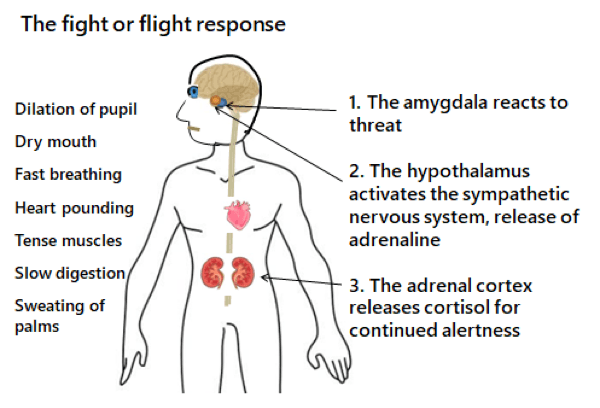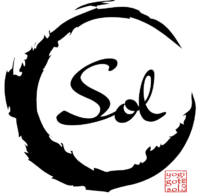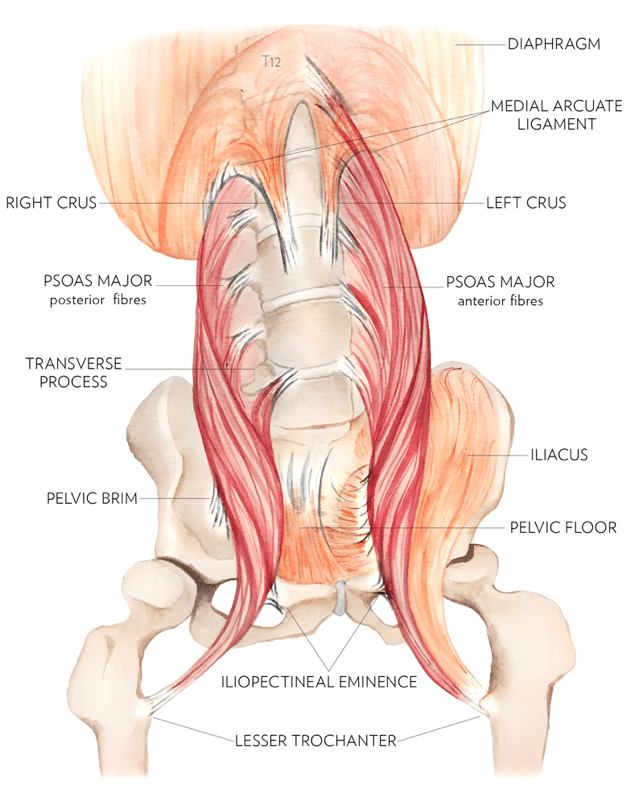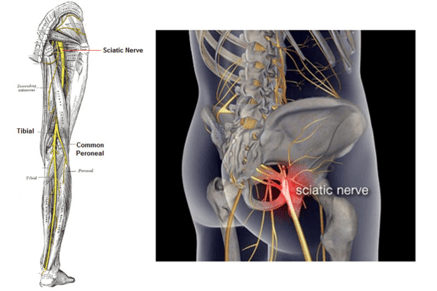If you fill in the blank: "My psoas are as sore as ____!" with an expletive, or if you don't know what the psoas is, then you might want to read on.
Did you know the psoas are the only muscles that connect the upper body to the lower body?
You probably never thought about it, and not only is it true, but we’ll try to explain why you should care. As illustrated, here, the muscle group is the direct connection from the lumbar vertebrae to the pelvis & femur.
Why is it important? Well, according to this National Institute, more than a quarter of adults reported experiencing low back pain during the past 3 months. Ironically, there’s a great deal of pain & discomfort associated with sitting on our butts. So, for many of us, it’s a topic worth exploring.
Physiologically speaking, it’s the center of gravity. Bands of tissue known as ligaments hold the Lumbar vertebrae (L1-L5) in place & tendons attach the muscles to the spinal column. 31 pairs of nerves are rooted to the spinal cord and they control body
movements and transmit signals from the body to the brain. These five little discs support a majority of the weight we carry in the upper body.
The psoas & connective tissues serve to stabilize those discs and connect to our legs for support.
One of the common ailments related to the sciatic nerve. The large nerve travels through the buttocks and extends down the back of the leg. Compression
on the nerve causes shock-like or burning low back pain combined with pain through the buttocks and down one leg, occasionally reaching the foot.
Why do we have a sciatic nerve? Each sciatic nerve stimulates movement of leg muscles and carries sensory messages from the leg to the spine.
Since the psoas connect the upper and lower parts of the skeletal system and the nervous system, additional emphasis is placed on this muscle group. Fascia tissue envelops the psoas muscle and it connects to the diaphragm. Problems with the psoas can cause tightness in the diaphragm, and vice versa. This is partly why the psoas are called the “fight or flight muscle.”
There’s much to be learned about the connection between our gut and our brain. The fight or flight
reaction is connected to the core of our brain; the amygdala and hypothalamus. As illustrated below, this activates the release of adrenaline and cortisol. Cortisol jacks up our appetite, in order to store up energy to “fight”, which might lead to weight gain. Cortisol is also released to the hippocampus, the part of our brain which is central for memorizing and learning. This is why we might have difficulties learning, concentrating, and regulating our emotions when we’re stressed out.

‘'The homeostatic definition of stress: A condition where expectations, whether genetically programmed, established by prior learning, or deduced from circumstances, do not match the perception of the environment. This discrepancy between what is observed or sensed and what is expected or programmed elicits patterned responses.’ https://www.medscape.com/viewarticle/704866_2
It should come as no surprise that when we are mentally stressed, the body can also be tense. Under stress, the Sympathetic nervous system works in overdrive until we feel safe again, and the Parasympathetic nervous system takes over to regain our balance.
Given these relationships, consider the service sector (as opposed to manufacturing) in which most of the labor force is seated at work. The mental stress is still there. All of the same Sympathetic nervous system actions and reactions occur; except, now, we’re sitting down. We’re not up & running from dinosaurs or fighting off hungry lions.
The psoas muscle group is designed to help us get up & go; either toward the fight or away from it. Instead, the muscles constrict while we’re seated, with the top of the femur closer to the pelvis and holding a different angle to the lumbar vertebrae. Meanwhile, the gut is storing up “energy” to get us ready for action. So, not only are we ingesting more food, but we’re likely to consume food that has more sugar than necessary.
Subconsciously, our minds and bodies seek balance. When we’re stressed, the brain waits for the “all clear” signal to tell the body to relax and activate normal functions, like our digestive system. When we’re under constant stress, some choose to artificially trick the Parasympathetic nervous
system – chemically.
Some chemicals – like Diazapem (a.k.a. Valium) – trick the brain & nervous system. When the mind
perceives everything’s all warm and fuzzy, the brain releases endorphins. These are natural opioids, produced by the body in response to pain, excitement and even exercise. The parasympathetic nervous system uses acetylcholine to allow the body to rest and digest, slowing the heart and
breathing, and diverting the blood supply to the gut.
Like other chemical drugs, sugar triggers the release of dopamine in the nucleus accumbens. (Basically, that’s near the root of the brain.) Too much sugar has actually been proven to change our gene expression and availability of dopamine receptors in the brain. By scanning brain activity in real-time, neuroscientists have shown that sugar leads to dopamine release. As the chemical tricks become a habit, it takes more-and-more sugar to attain the same “high.”
Beyond the physiological impact of our stressed psoas, there’s more evidence that there are actually long-term psychological impacts, as well. Maybe the authors of our ancient texts knew more about this “gut feeling” than science could prove at the time. In translations of the Bible, the Greek word for Compassion is derived from, splanchnízomai, which refers to a visceral feeling in the bowels. In Sanskrit, the word Karuṇā describes a similar sentiment as the ancient Greeks. This word is translated to mean any action that is taken to diminish the suffering of others and could also be translated as “compassionate action.” Read more about this in our Blog “Karuṇā: Seeking Genuine Compassion in a Virtual Age”
Interested in learning more about the Brain-Gut relationship with your Psoas, stay tuned. This is one part in a series of blogs we’ll post on the subject.
In the meantime, take it easy. Find a few moments of mindfulness – just pause, bring awareness to your
breath, and stretch out your psoas!
Next up, we’ll offer a test to see if your psoas are too tight, along with some helpful stretches.
And, we’ll dive deep into a segment about the possible withdrawals when you give up sugar
https://www.cnn.com/2017/03/02/health/sugar-brain-diet-partner/index.html


